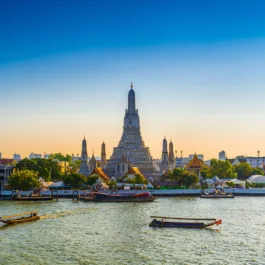The Treasures Of Thailand PROMOTION
Thailand’s Top 10 Most Scenic Nature Spots
Slide Nr 1White-gold beaches. Otherworldly cave systems. Rainforests overflowing with super-sized flora and fauna. Rivers that bend and weave through rice fields and farmland. Limestone islands that drip into jade-green seas like melting ice-cream – Thailand’s landscapes are as diverse as they are mesmerising. From well-known nature hotspots to lesser-known corners of the country, here’s our pick of the top 10 most scenic destinations for basking in the wild and natural beauty of Thailand.
0/11
The Treasures Of Thailand PROMOTION
Thailand’s Top 10 Most Scenic Nature Spots.
Slide Nr 2A JOURNEY OF HOSPITALITY
With Thai Airways offering dozens of daily flights direct to Bangkok from top cities around the world, it has never been easier – or more pleasant – to reach the fascinating and mysterious natural wonders of Thailand. Settle in with authentic Thai meals and the famed warmth of Thai hospitality on every flight, and land well-rested and ready to explore this jewel box of a country. Find out more about flying with Thai Airways here.[SPONSORED]
1/11
The Treasures Of Thailand PROMOTION
Thailand’s Top 10 Most Scenic Nature Spots.
Slide Nr 3Khao Yai National Park – You’ll find the natural marvels of Khao Yai National Park, the first to be established in Thailand, a scenic three-hour drive north of Bangkok. Fashionable Bangkokians like to pop up at the weekend; they come for the gorgeous art galleries, stylish restaurants and vineyard wine-tastings, as much as they do for the hiking trails, waterfalls, night safaris, rare birdlife and herds of wild elephants. STAY: Located on the leafy edge of the national park, boutique bolthole Roukh Kiri has chic cream and teak cabin-style villas with private pools and sweeping views of the golden hued countryside.
2/11
The Treasures Of Thailand PROMOTION
Thailand’s Top 10 Most Scenic Nature Spots.
Slide Nr 4Similan Islands National Park – One of Thailand’s most aspirational diving and snorkelling destinations, this cluster of 11 eclectic limestone islands – some with dazzling white beaches, others with fantastical boulders, all set in crystalline waters teeming with fish and corals – are located a 90-minute speedboat ride from Khao Lak, a cheerful beachside town to the north of Phuket. Overnight stays are generally not permitted in this protected zone, but Khao Lak, with its seemingly endless golden beach, makes the perfect jumping off point. STAY: Among the most popular repeat guests at JW Marriott Khao Lak Resort & Spa are the sea turtles who come to lay their eggs on the beach out front. You can learn about them at the Turtle Conservation Centre – when not flitting between your lagoon villa and the pool.
3/11
The Treasures Of Thailand PROMOTION
Thailand’s Top 10 Most Scenic Nature Spots.
Slide Nr 5Koh Yao Noi in Phang Nga Bay – Home to Koh Phi Phi, Koh Tapu (known as James Bond Island) and Maya Bay, made famous as the backdrop to Leonardo Di Caprio’s blockbuster movie The Beach, Phang Nga Bay is Thailand’s most cinematic beauty. It is famed for its luminous green waters, towering sea-stacks, limestone cliffs, mangrove forests, aquamarine lagoons and exquisite beaches – and there’s nowhere better to admire its beauty than from the island of Koh Yao Noi, which – despite its mid-bay location – remains blissfully off the main tourist grid. STAY: Set your alarm at Six Senses Yao Noi to behold the view of the sunrise silhouetting the toothy limestone karsts of Phang Nga Bay, as the Andaman Sea morphs from indigo to violet to neon green.
4/11
The Treasures Of Thailand PROMOTION
Thailand’s Top 10 Most Scenic Nature Spots.
Slide Nr 6Pai Canyon in Mae Hong Son – Populated by a crossover of Burmese and Northern Thai Lanna peoples and hill tribes, this remote area makes for some of the most scenic hiking in the country. Take the trail to the narrow Pai Canyon mountain ridge, where the bucolic landscape unfolds before you, all rippling green mountains, glassy lakes, wildflower fields and rice terraces. Alternatively, you could tour the Mae Hong Son Loop in your own bright orange tuk-tuk with The Tuk Tuk Club. STAY: Ringed by lush mountains, lime-green rice fields and bird song, Fern Resort has 35 bungalows fanning out from the swimming pool and is, by far, the nicest place to stay in this distant corner of the country.
5/11
The Treasures Of Thailand PROMOTION
Thailand’s Top 10 Most Scenic Nature Spots.
Slide Nr 7Khao Sok National Park in Phang Nga – There are leaves as big as blankets, trees as tall as skyscrapers and lakes the size of cities inside this vast tropical rainforest, situated on the mainland north of Phuket. A patch of rainforest older and more diverse than the Amazon, Khao Sok is estimated to contain 5% of the world’s known species, from the planet’s largest flower (the stinking Rafflesia), to weird amphibious centipedes, as well as squirrels, deer, tapir, gibbons, wild boar, bears, tigers and elephants. STAY: It may be far more eco-friendly than fancy, but the food at Our Jungle House is fantastic and rooms are spotlessly clean – and as close as you can get to nature without sleeping outdoors. Book a treehouse for added atmosphere (and fewer snakes).
6/11
The Treasures Of Thailand PROMOTION
Thailand’s Top 10 Most Scenic Nature Spots.
Slide Nr 8Tham Luang Caves in Chiang Rai – The nail-biting 2018 rescue of the Wild Boars Thai youth football team has transformed this previously little-known cave system into a fascinating tourist attraction. Aside from the daring rescue, which you can learn about at the new museum, the location is exceptionally pretty, with gardens dotted with golden buddha statues and stone stairs leading up to great yawning caverns, tunnels of stalactites and secret grottos, all surrounded by rolling Chiang Rai countryside. STAY: Set at a confluence of the Mekong River which joins Thailand, Myanmar and Laos, Anantara Golden Triangle is one of Thailand’s most romantic stays, with a long-tail boat arrival, atmospheric rooms, and rescue elephants wandering the expansive grounds – book a bubble tent to spend the night with the giants.
7/11
The Treasures Of Thailand PROMOTION
Thailand’s Top 10 Most Scenic Nature Spots.
Slide Nr 9Erawan Falls in Kanchanaburi – Named after the mythical three-headed elephant Hindu god, this extraordinary waterfall percolates over 1,500-metres down seven spectacular tiers through dozens of luminous teal-green rock pools shaded by dense rainforest. A 2km nature trail leads to the various pools, which visitors can swim in – so don’t forget to pack swimwear as well as decent footwear. Most visitors stop at the third level, but level four has a natural waterslide, and few make it as far as level six, so it’s worth the climb. To see the falls at their fullest, visit in the rainy season between May and October. STAY: An extension of the high-style Z9 Resort, where neo-earthy rooms float on the banks of the River Kwai, the two-bedroom Pla2 Villa floats entirely separate from the world in the middle of the Srinagarind Dam. Aside from soaking up the sleek Scandi-Thai design, guests can also kayak, SUP, dip in the salt water swimming pool and waterslide into the water.
8/11
The Treasures Of Thailand PROMOTION
Thailand’s Top 10 Most Scenic Nature Spots.
Slide Nr 10Ang Thong National Marine Park in Surat Thani – Tempting visitors from the beach, this marine life haven swirls just off the coast of Koh Samui. Spread across 90sqm of turquoise Gulf of Thailand, it’s home to 40 limestone islands, large and small, sporting talcum powder beaches and amazing biodiversity, including numerous corals – staghorn, elephant’s tusk, sea fans and brain coral as big as bungalows – as well as butterfly fish, parrotfish, stingrays and pulsating purple clams. At least one boat trip exploring this aqua-playground is a must. STAY: If the (very strong) rumours are to be believed, the ultra-luxury Four Seasons Koh Samui is where season 3 of The White Lotus is being filmed. Flex your Amex and get ahead of the crowds that will inevitably follow the TV show’s 2025 release.
9/11
The Treasures Of Thailand PROMOTION
Thailand’s Top 10 Most Scenic Nature Spots.
Slide Nr 11Khao Chin Lae Sunflower Fields in Lopburi – Part of the ancient kingdom of Ayutthaya, Lopburi Province is best known for its surreal riverside town where huge troops of macaques run wild among ancient ruins, former royal palaces and Buddhist shrines – the result of y myth in which King Rama gifted the city to the monkey god Hanuman. Less well-known is Lopburi’s dishy fields of sunflowers, which flow like a yellow silk all the way to sleeping dragon mountains. The flowers bloom between November and February, reaching their full height in December. STAY: There’s nothing in the way of luxury accommodation in this underdeveloped part of the country, but the Lopburi Inn Resort has clean, comfortable, quiet rooms, a Chinese-Thai restaurant and a pretty communal swimming pool – for a very reasonable rate.
10/11
The Treasures Of Thailand PROMOTION
Thailand’s Top 10 Most Scenic Nature Spots.
Slide Nr 12Emerald Cave in Trang Province – Known locally as Tham Morakot, a visit to this sea cave delivers one of Thailand’s most enchanting experiences. Swim or kayak in glowing green waters through low-slung tunnels and shadowy caverns that eventually lead to a secret lagoon in the heart of the island. Inside feels like being in an amphitheatre of nature, with a hidden white beach buffeted by high rock walls draped in tropical foliage soaring skywards. As part of Hat Chao Mai National Park, the cave is only open from November to April, and is given time to recover during the rest of the year. STAY: Considered to be one of the best hotels in Asia, every moment at Soneva Kiri feels like an adventure, from the huge Robinson Crusoe-esque pool villas, to breakfast served on a long-tail boat cruise, hornbill-spotting adventure tours, and outdoor cinema nights on the beach.
11/11




Sorry, the comment form is closed at this time.